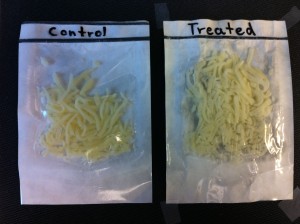By Markus Walkling-Ribeiro, Adi Md Sikin and Dr. Syed Rizvi
Sustainable and safe preservation of cheese, avoiding spoilage or pathogenic contamination from production to consumption, has been a food processing challenge for a long time. In 2013 mozzarella ranked first, with a 33.4 percent share of 11.1 billion pounds of cheese produced in the United States (USDA, 2013). Its commercial relevance is well indicated by the main consumers, food service or fast food chains, using the dairy product, for instance, as topping in baked preparations such as pizza and au gratin dishes or as an ingredient in other foods (Mastromatteo et al., 2014). However, having to maintain the cold chain after cheese processing to minimize microbial growth, extend the shelf-life and retain the physico-chemical and organoleptical quality is still a major drawback based on the energy requirements and costs for refrigeration, location and climate dependant availability, and the associated lack of convenience for consumers to keep the cheese refrigerated at all times.
For this reason our food process engineering research group has developed a new hurdle technology to enable ambient temperature storage of cheese (at 25°C and below). In order to achieve this objective supercritical carbon dioxide (SCCO2) and peracetic acid (PAA) were applied alone and in combination to study the effect of these processing technologies on shredded mozzarella cheese, that has either been spoiled with native microorganisms (bacteria, yeasts and molds) or inoculated with surrogates (Escherichia coli, Listeria innocua, and Geobacillus stearothermophilus) for pathogenic bacteria.
SCCO2, applied at 7.3 MPa and 31°C or higher, induces a pasteurizing/sterilizing effect on food products by means of adjustable densities, low viscosities, high diffusivities and low interfacial surface tension that facilitate its penetration into various matrices (Sikin and Rizvi, 2011). Besides its efficacy against a wide range of microorganisms, another advantage of this high pressure technology is that it does not affect the stability of most food matrices and it can also be easily handled at industrial scale. It is also noteworthy that SCCO2 is nontoxic, non-flammable, chemically inert and a solvent with generally recognized as safe (GRAS) status leaving no residue upon removal from the product
Application of PAA has been reported to enable at least a reduction of 6 log cycles of various spores in medical devices by SCCO2-based surface sterilization (Qiu et al., 2009). For combined treatments, the role of SCCO2 is to act as vector, so that PAA can easily penetrate into the microbial cells and inactivate them at only hundredth to thousandth ppm.
Shredded Mozzarella was slightly compacted by the SCCO2 treatment but retained its original appearance as shown in Figure 1.
The most effective treatment (SCCO2 at 1500 psi combined with 100 ppm PAA for 30 min) inactivated all vegetative microorganisms in the cheese by 4.6 log cycles or higher stored over a storage period of 21 days at 25°C, which is comparable to the total bacteria count found in refrigerated, shelf-stable mozzarella-type cheese purchased at a local supermarket. Synergistic treatment effects between SCCO2 and PAA and inactivation up to 3.8 log10 of G. stearothermophilus spores also highlight the efficacy the efficacy of the hurdle technology, rendering it a highly productive alternative to conventional cheese preservation strategies that rely on product refrigeration.
References:
Mastromatteo, M., Conte, A., Faccia, M., Del Nobile, M.A., Zambrini, A.V., 2014. Combined effect of active coating and modified atmosphere packaging on prolonging the shelf life of low-moisture Mozzarella cheese. Journal of Dairy Science 97, 36-45.
Qiu, Q., Leamy, P., Brittingham, J., Pomerleau, J., Kabaria, N., Connor, J., 2009. Inactivation of bacterial spores and viruses in biological material using supercritical carbon dioxide with sterilant. Journal of Biomedical Materials Research Part B: Applied Biomaterials 91, 572-578.
Sikin, A.M., Rizvi, S.S., 2011. Recent patents on the sterilization of food and biomaterials by supercritical fluids. Recent Patents on Food, Nutrition & Agriculture 3, 212-225.
USDA, 2013. USDA dairy products 2013 summary. National Agricultural Statistics Service. United States Department of Agriculture. Retrieved July 17, 2014, from http://www.usda.gov/nass/PUBS/TODAYRPT/daryan14.pdf


